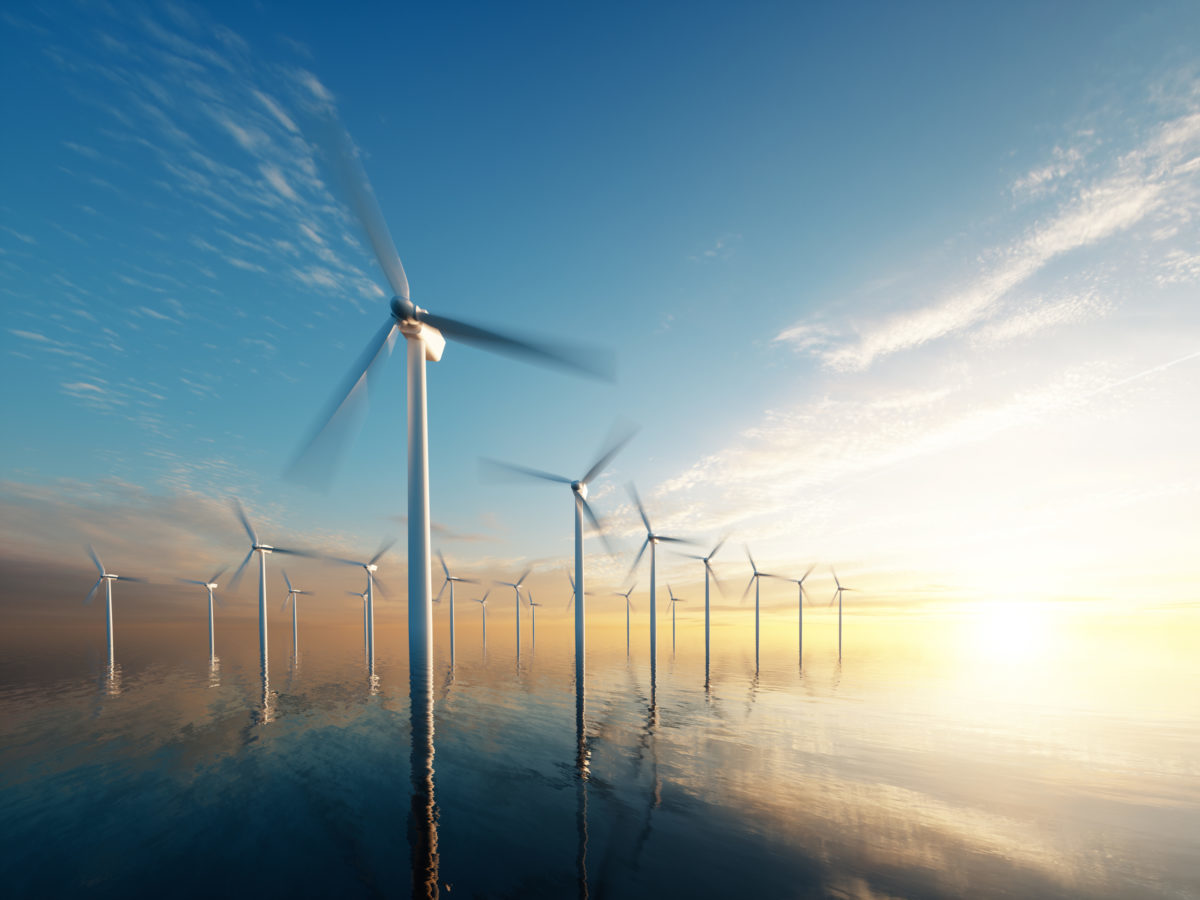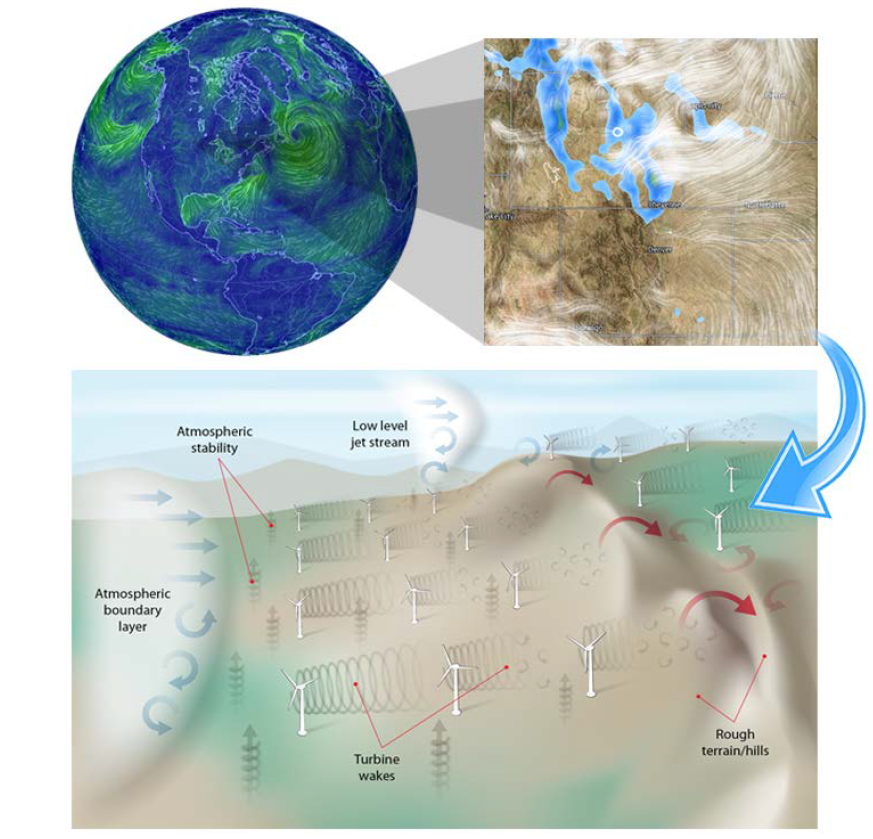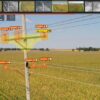
With wind power now exceeding hydro power as the largest source of renewable energy in the U.S., variations in intermittency of different sources of renewable energy are driving ever-more complex analytics requirements which need to be addressed now more than ever. New advanced analytics tools will be playing a key role in siting and designing wind farms for maximal capacity, and in optimizing real time dispatch.

Illustration by Josh Bauer and Al Hicks, National Renewable Energy Laboratory (NREL).
Analytical tools are undergoing significant ongoing improvements in order to address higher levels of uncertainty and dynamism in electric grid operations going forward. In addition, when it comes to wind farm design, advanced analytics is required for complex calculations to model optimal placement of wind turbines, because of variations in how one wind turbine can reduce the output of turbines located nearby.
It was recently announced that Vestas, a leader in wind power, is to acquire Utopus Insights, an energy analytics and digital solutions company. The acquisition will allow Vestas to pursue digital opportunities and expand its service offering. Utopus Insights has developed a suite of digital products, and holds over 30 patents based on its expertise in data science, analytics, power engineering, energy software development, and meteorology.
From this recent $100 million Vestas advanced analytics-related acquisition announcement, to the importance of wind farm design and dispatch optimization as part of high-profile strategic initiatives for the U.S. to regain competitive advantages associated with development of the next generation of the world’s most powerful supercomputers, advanced analytics is at the forefront of wind power specifically, as well as energy independence in general.

Job Growth in Renewables and Analytics
In terms of jobs in the next ten years in the U.S. solar photovoltaic and wind power are projected to drive the #1 and #2 highest job growth areas percentage-wise.
When it comes optimizing power dispatch utilizing the best-possible local short-term weather forecasts, wind and solar are driving similar advanced analytics requirements.
The labor statistics also show that there will also be high demand for statisticians and mathematicians generally, with the former role representing the next-highest growth rate profession outside of health-care related work.
As shown in the table below, solar photovoltaic installer jobs in the U.S. will more than double in the next ten years, growing to 23 million by 2026. In addition, the U.S. currently employs 5,800,000 wind turbine service technicians, and projections indicate this figure will grow to 11,300,000 by 2026.
| Table 1. Top Occupations in the U.S. Ranked by Ten-Year Growth Rate (%) | |||
| Occupation | 2016 Employment (Millions) | 2026 Employment (Millions) | Percent change |
| Solar photovoltaic installers | 11 | 23.1 | 104% |
| Wind turbine service technicians | 5.8 | 11.3 | 95% |
| Home health aides and Personal care aides | 2,927.6 | 4,136.5 | 41% |
| Physician assistants and Nurse practitioners | 140.3 | 183.0 | 37% |
| Statisticians | 37.2 | 49.8 | 34% |
| Physical therapist aides and assistants | 88.3 | 115.8 | 31% |
| Software developers, applications | 831.3 | 1,086.6 | 31% |
| Bicycle repairers | 12.4 | 16.1 | 30% |
| Forest fire inspectors and prevention specialists | 1.7 | 2.2 | 29% |
| Mathematicians | 3.1 | 4.0 | 29% |
Source: Bureau of Labor Statistics – Employment by major occupational group, 2016 and projected 2026
Wind Power in NPR Coverage of World’s Fastest Supercomputer
In a recent story on National Public Radio, “China makes big strides over the U.S. in supercomputers,” an example was provided of the huge difference in time involved to optimally site and design a wind farm, depending on the power of the computer performing the analysis.
“Suppose a company wants to build a wind farm. It would need to know where the strongest wind energy is,” noted the NPR reporter interviewing the operator of the world’s fastest supercomputer, the Sunway TaihuLight, located in China. The operator, Gan Lin, stated “Calculating where the strongest wind in the world is over the course of a year used to take three months in China. The Sunway TaihuLight can find the answer in one week.”
As part of wide-ranging plans for infrastructure upgrades in the U.S., low-cost wind power will improve energy independence, wind power is expected to grow by more than 8 GW in 2018 and 8.3 GW in 2019.

Source: U.S. Energy Information Administration, Annual Electric Generator Report, Form EIA-860, Electric Power Monthly
The U.S. DOE Exascale Computing Project
Energy security is one of the key drivers for major efforts by the U.S. to regain the title it lost in 2013, of possessing the world’s fastest supercomputer.

Source: DOE Exascale Computing project
Specifically, late last year, the U.S. Department of Energy awarded contracts to six U.S. companies to regain the top position in world-wide supercomputing. The six contracts, which totaled to more than a quarter of a billion dollars, were awarded to AMD, Cray, HP, IBM, Intel, and Nvidia. Along with modeling nuclear fusion, the utilization of these new so-called exascale computers for modeling wind farm aerodynamics has been noted in multiple reports (e.g. See this DOE Update on the Exascale Computing Project by Paul Messina, or this 6/15/2017 article in Fast Company.)

Source: DOE Exascale Computing project
Vestas Acquisition of Energy Analytics and Digital Solutions Company
As the global energy sector is transforming, Vestas is looking to offer customers digital solutions to deliver greater predictability, increased renewable energy production, more efficient operations, and better integration with energy grids.
This transformation means energy systems and power plant owners must improve forecasting accuracy for renewable production, optimize output from each individual generation asset and orchestrate a portfolio of resources across multiple sites and equipment types. They must also do so in a cost-effective manner that ensures grid stability as renewable energy sources gradually replace conventional, fossil-fuel generated power plants.
“Vestas’ strategic objective is to accelerate the transition towards a fully decarbonized energy sector in the most efficient and cost-effective way possible – both for our customers and for our planet”, said Anders Runevad, Vestas’ Group President and CEO, who added that the acquisition improves Vestas’ existing capabilities “for advanced analytics and integrated energy software solutions. We will now be able to provide our customers improved forecasting, output optimization and coordination between assets, and support the larger energy ecosystem’s increased uptake of renewable energy”.
US-based Utopus Insights has its origins in IBM’s Smarter Energy Research Institute and has a pedigree in data science, software, utility operations, meteorology, and renewable and distributed energy.
Vestas and Utopus Insights will also sign joint development agreements that support advanced predictive and prescriptive analytics products.
“Utopus Insight’s mission is to accelerate an era of distributed, reliable, clean and cost-effective energy”, said Utopus Insights CEO, Chandu Visweswariah.
“Vestas can now provide customers with additional digital tools that can further leverage available data, increase their operational agility and help them make smarter decisions to lower their costs, increase their revenues and better manage their power plants”, said Christian Venderby, Group Senior Vice President and Head of Service at Vestas.
More information on the Vestas acquisition is available at this link.














